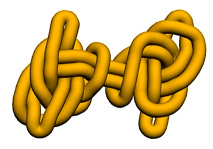The Gordian Knot
The Phrygians were an 8th century BC people closely related to the ancient Greeks who lived in a region that's now modern day Turkey. They had found themselves without a king after a long period of unrest, with no clear heir to the throne.
Legend has it that an oracle visited them and said that the next man who walked through the gates with an ox-cart would be king. Gordius, a poor farmer, happened to walk through the gates of Phrygia the next day with his ox-cart. They made him king, and as an offering to Zeus, Gordius tied up his ox-cart to a post. The knot was so complex and intricate that nobody could figure out how to untie it. It became known as the Gordian Knot.
The Gordian Knot lasted for 300 years. Some said that whoever was clever enough to release it would not only rule Phrygia, but all of Asia. Then, in 333 B.C. a young king from Macedonia came through Phrygia with his army. He tried to untie it, but couldn't figure it out.
Then the young king took his sword and cut through the knot with a single swipe. It didn't matter how the knot was untied. The young king was Alexander the Great.
The Gordian Knot has become a metaphor for an impossible problem that is only solved by removing assumed constraints that aren't actually constraints. It's possible that the knot was unable to be untied, it could have been two ropes that were weaved together. A mathematician named Piortr Pieranski came up with a possible structure for the Gordian Knot that would have been impossible to disentangle.

Maybe Alexander didn't conform to the spirit of the puzzle, but it goes to show that sometimes we can find elegant and simple solutions to intractable problems by challenging our assumptions.

